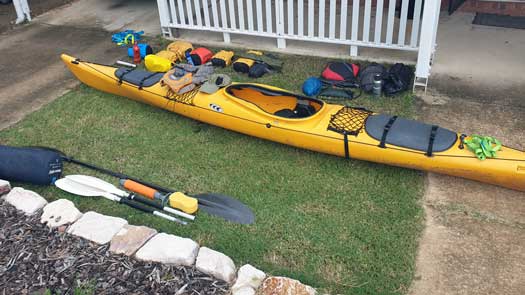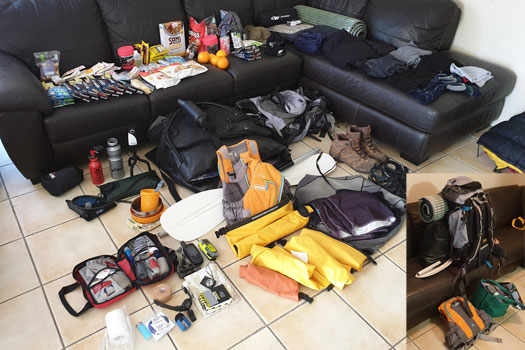Paddling Gear
Core and recommended gear to take, including safety gear
Essentials for surviving the trip down
Carry as little as possible, but choose that little with care.

My gear list for the trip was minimalistic in a way, but also fairly compreshieve for a self-supported trip. This sounds contradictory, but I carried everything I needed and I would have been able to fix most things other than the electronic items.
But before looking at my gear list, a minimalist camping list is a good way to really consider what you need and what you want. If I was heading out for just one or two nights, my gear list would likely match the following minimalist camping list. If I was to head out for five or more nights, it would probably be similar to what I took on my main trip down the lower Murray.
A minimalist camping list:
Most people probably couldn't live without their mobile phone. Add a solar panel and power bank if you want to be self-sufficient.
My personal kit was a tad bigger! This list below may seem like a lot, but I could easily fit most of the items I used daily into the front hatch with a week's worth of food. In the rear hatch I stored additional food, spare clothes and other infrequently used items.
1 Worn once. These were more for emergencies if cold weather hit, especially after taking a swim.
2 For the occasional shop and the 18 hour bus trip back to the car.
3 Used for a windbreak and mozzie guard on a few occasions. If it was raining, I was in my paddle gear on the water, or in the tent. In saying that, this is a vital safety item in the alpine zone.
4 One litre of fuel was enough for one month when simply boiling water for dinner and morning coffees.
5 Flask is an old Artic explorers trick. Boil the water at night for instant hot water in the morning. Saves both time and fuel when using a MSR cooker.
6 Bivy allowed camping with minimal space and with a very low profile.
7 Brought on the road after 6 weeks on the water. Better first-aid kit scissors would have sufficed.
It is difficult to say what I would trim from my list if I had to do another month long trip.
The most obvious is the camera, but I still prefer it over my phone for the real zoom, even though it is bulky and it requires a pelican case. Both the camera and MP3 player allowed me to turn off my phone to conserve battery power as required. This was handy when my charging cable for my phone broke when in the middle of nowhere.

The Upper Murray section was shorter and I only carried a bivy (no tent). I wore tramping boots and had two sets of warm clothes for the Alpine hiking sections as well as my lightweight paddling clothes. Mix of woollen and polypro thermals, especially as wool is more fire resistant and warmer when wet. I ended up wearing my polypros with my paddle gear during the day and using my woollen thermals at night to keep warm.
I used a Life Straw rather than the heavy ceramic water filter and I didn't need to clarify the water before using it. Being much shorter, I carried minimal repair gear. While I took a complete first aid kit on the main run, I used a minimal kit on the gear drop consisting of just tape and a couple of bandages for snakes, sprains and breaks only. I also only used my phone rather than taking a camera. No personal items other than a small diary, toilet paper and toothpaste. No trowel, toilet holes can be dug with a stick easily enough.
If I would do the top section again, apart from using a lightweight packraft, I would probably drop my cooker. That would mean living off cookless camping meals for a week and foregoing my morning coffee.
©2026 Alan Davison // Credit // Disclaimer